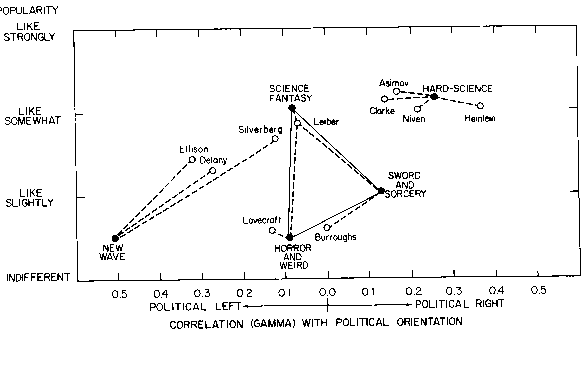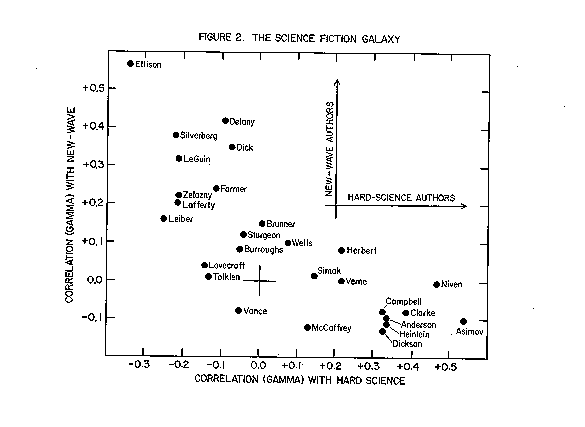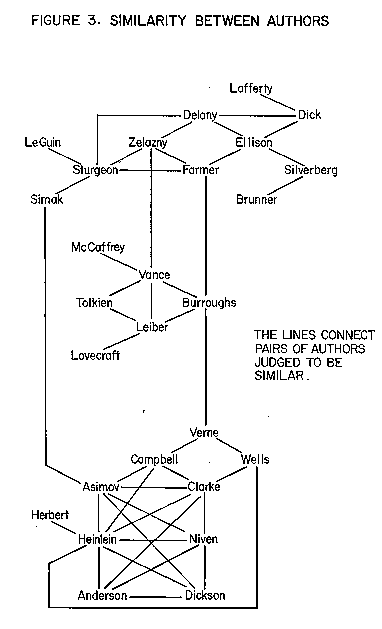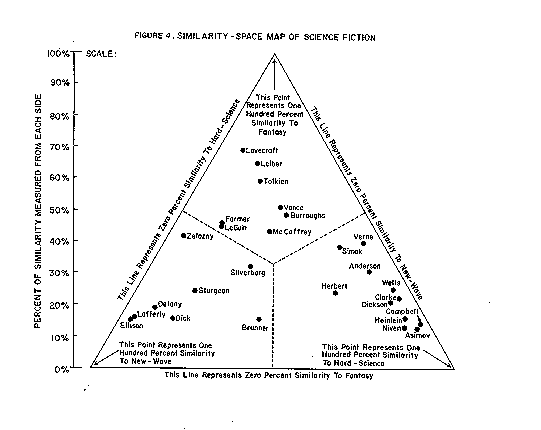# 15 = Volume 5, Part 2 = July 1978
William Sims Bainbridge and Murray Dalziel
The Shape of Science Fiction as Perceived by the Fans
Science fiction deserves scientific analysis. While conventional qualitative literary analysis has been extended to science fiction in a progressively more refined manner, quantitative analysis of the structure and content of SF has seldom been attempted. Therefore, this article is a step in a new direction, presenting the chief results of a quantitative analysis of the relationships perceived by readers among twenty-seven authors and several types of literature. So that our statistical findings will be generally intelligible, we have presented them in four charts, analogous to maps of physical territory, defining the shape of science fiction.
What does our work achieve? We verify the suspicion of other critics that the field can be divided into three main realms: Hard-Science SF, New-Wave SF, and a cluster of types of Fantasy. Our research goes beyond mere typification to the actual measurement of the differences and similarities perceived by readers between authors and literary types. The research instrument was a questionnaire completed by 130 editors of American fanzines and their associates. These men and women acted as literary experts, but the statistical techniques we used permitted us to construct and explore a more objective picture of the field than any individual could have given.
The first two of our charts are based on a number of preference items in the questionnaire. We presented each respondent with a list of 27 authors and 17 kinds of literature, and asked him to say how much he liked or disliked each one, on a seven-point scale. Twenty of the authors were all the writers who won Hugo awards for fiction in the ten years 1963-1972. We added seven other authors, mainly earlier ones, to extend the list in breadth and historical perspective. The literature types included all the expressions for different kinds of SF we had seen used in fanzines and in conversation among fans, augmented by a few other kinds of literature that also came up in such discussions. We also asked a political question to determine the respondents' orientations on current political issues. The data from these questions were analyzed by calculating statistical correlations. That is: Did those fans who liked author X also tend to like author Y? Or: Which authors are preferred by those fans who prefer literature type Z? Thus we used the likes and dislikes of fans to explore the connections between different writers and kinds of literature.
Our third and fourth charts are based on another set of questions, specifically focusing on similarity between authors, answered by 66 of our respondents. We gave each of them a randomized list of the 27 authors, with the following instructions: "After the name of each author below, please enter the names of the authors most similar to him or her which are on the list of names." Data of this kind are somewhat more difficult to handle statistically than the preference data, but provide a good check on the validity of our analysis.
The Three Science-Fiction Constellations.Figure 1, which happens to look very much like a traditional star map, charts five types of science fiction and ten authors. The vertical dimension is the strength with which the average fan likes each type and author, with the best-liked near the top, and the least-liked at the bottom. The horizontal dimension represents the correlation between authors or literary types and political orientation. The left side of the map shows the fiction preferred by left-wing readers, and the right side shows the fiction preferred by right-wing readers. The solid and dashed lines linking authors and styles of literature show some significant positive associations revealed in our statistical analysis. Three "constellations" are readily apparent to the eye: Hard-Science, New-Wave and a Fantasy Cluster.
Hard-Science SF is a completely unambiguous term. It refers to stories built around certain facts or speculations concerning the "exact" or "hard" sciences, and is usually optimistic about the value of scientific and technological progress. There is a tendency for Hard-Science to be associated with the political right (gamma = 0.26), and fans whose own political orientation is Moderate or Conservative show a tendency to prefer this type of fiction. Those who particularly like Hard-Science also tend to enjoy reading factual reports on the space program and on spaceflight (gamma = 0.36). Nine of our authors were strongly associated with Hard-Science, with Asimov (Gamma = 0.54) heading the list, followed by Niven, Clarke, Anderson, Heinlein, Dickson, Campbell, Verne, and Herbert, in that order.
Although the term "New-Wave" is well known to science fiction fans, an exact definition is hard to find. Our correlational analysis has established several characteristics of this type of literature. New-Wave SF is strongly associated with the political left (gamma = 0.51), and is preferred by readers who consider themselves politically Liberal or Radical. We found that four descriptive phrases were significantly associated with New-Wave: avant-garde fiction which experiments with new styles, fiction concerned with harmful effects of scientific progress, utopian political novels and essays, and fiction which deeply probes personal relationships and feelings. Eight authors were strongly connected with New-Wave, with Ellison (gamma = 0.57) heading the list, followed by Delany, Silverberg, Dick, LeGuin, Farmer, Zelazny, and Lafferty, in that order.
The Fantasy wing of science fiction is divided into at least three related parts. We found a strong association between sword-and-sorcery and science-fantasy (gamma = 0.50). Smaller correlations linked these two types with horror-and-weird fiction (gammas = 0.24, 0.18). Figure 1 represents these connections as solid lines linking the three types into a Fantasy Cluster. It is quite separate from either Hard-Science or New-Wave and has no particular political orientation. Burroughs is the leading sword-and-sorcery writer (gamma = 0.35), while Leiber leads in science-fantasy (gamma = 0.40), and Lovecraft dominates horror-and-weird (gamma = 0.76). Other authors that write Fantasy at least part of the time are: Anderson, Dickson, Farmer, McCaffrey, Simak, Tolkien, Vance, and Wells.
The Science-Fiction Galaxy. Figure 2 maps the association between each of the twenty-seven authors and the two extreme types of fiction, New-Wave and Hard-Science. The vertical dimension represents the correlation (gamma) between New-Wave and each author. The horizontal dimension represents the correlation between Hard-Science and each author. Thus, New-Wave authors, who tend also to have negative correlations with Hard-Science, are positioned in the upper left corner of the chart. Hard-Science authors are in the lower right corner. Writers who are not strongly associated with either type are near the center. The galaxy of authors is somewhat banana-shaped because there is a negative correlation (gamma = 0.25) between the two types of fiction.
Similarity Between Authors. Figure 3 uses the similarity data to show connections between individual authors. In this chart, unlike the other three, distance between points has no meaning. The names were positioned to make the chart as clear as possible to read. The lines connect authors that eleven or more of the sixty-six respondents felt were similar. The number eleven (1/6 of the total possible) was chosen because it was the highest number that revealed at least one connection for each author. For instance, 14 people said Silverberg was similar to Ellison; 17 said Brunner was similar to Silverberg, but only three said Ellison was similar to Brunner. So we drew lines connecting Ellison with Silverberg and Silverberg with Brunner. We did not draw a line connecting Brunner with Ellison.
This similarity chart is rather like a road map. One can start with any author and trace one's ways from author to author, at each step moving between authors that are very much like each other. But the eye immediately spots three groups of authors, the same three types we have already identified. At the top we see the New-Wave writers; in the middle is the Fantasy Cluster, and Hard-Science is at the bottom. The great density of lines connecting Hard-Science authors is not only the result of their close similarity but also reflects their great popularity. When a respondent is asked to think about any one of these writers, the names of the others come quickly to mind.
Although these groups are pretty much distinct, certain authors are bridges between the different styles. This is consistent with literary creativity. Writers often experiment with different styles. The connections linking Zelazny with Vance and Simak with Asimov are actually rather weak, mentioned by few of our respondents, but they undoubtedly express the versatility of Zelazny and Simak as writers. The single author that is the strongest link connecting the three groups is Burroughs, but this may be the result of two accidents, rather than representing a real bridge between the types. Burroughs and Verne share the characteristic of antiquity. Both were born, wrote, and died many years ago. The connection between Farmer and Burroughs can be explained by the fact that Farmer has earned extra fame and money by writing sequel books in Burroughs' extremely popular Tarzan series. Thus, although there are some connections linking the three groups, the map really shows three separate clusters of authors.
Similarity-Space Map of Science Fiction. Figure 4 is very easy to read with the eye, but somewhat more difficult to understand intellectually. The data it represents are the complete set of similarity judgments, a total of 2,838, made by the 66 respondents. The twenty-seven authors are graphed inside an equilateral triangle divided into three regions. The Fantasy Cluster writers are near the top; Hard-Science writers are at the lower right, and New-Wave writers are at the lower left. This chart examines the Science Fiction Galaxy from a new direction, probably from the vantage point that best reveals its natural structure.
The intellectual subtlety of this chart is that it appears to map three dimensions on a flat plane without any distortion. But we have always been taught that this is impossible! However, the geometric properties of the triangle and the statistical properties of the similarity data, make it quite possible. In making the chart, we combined information from Figure 2 and Figure 3. Nine authors are identified as Hard-Science writers by Figure 2, and eight are associated with New-Wave. With these two lists in mind, we looked at similarity data for each of the twenty-seven authors. For example, when we asked who was similar to Zelazny, there were altogether 127 responses. A total of 69 of these (54%) were the names of authors we had identified in Figure 2 as New-Wave writers. Only five responses (4%) were the names of Hard-Science writers, but 53 (42%) were names in neither of these two categories, predominantly Fantasy Cluster writers. The three sides of the triangle represent points of zero similarity to one or another of the three types. In setting the scale for the chart, we let the altitude of the triangle (the perpendicular distance from any corner to the opposite side) equal to 100%. We located Zelazny's point by measuring 54% of this distance perpendicular from the zero New-Wave line, 4% from the zero Hard-Science line, and 42% from the zero Fantasy line. The same process was used to plot the other twenty-six authors. Mathematically inclined readers may amuse themselves by figuring out why this chart introduces no distortion in mapping all three types of science fiction at once.
Charts such as the four published with this article may be taken as the starting point of literary discussions and of further quantitative research. Statistical techniques can be used to examine much finer details of writing style, to compare individual novels and stories, and even to analyze changes in science fiction writing over time. Our twenty-seven authors, although among the best, still constitute but a tiny fraction of all SF writers. There is much work to be done in the scientific analysis of the shape of science fiction.
ABSTRACT
This article presents the chief results of a quantitative analysis of the relationships perceived by readers among twenty-seven authors and several types of literature. The research instrument was a questionnaire completed by 130 editors of American fanzines and their associates. So that our statistical findings will be intelligible, we have presented them in four charts that taken together define the shape of science fiction. We verify the suspicions of other critics that the field can be divided into three main realms: Hard-Science SF, New-Wave SF, and a cluster of types of Fantasy




